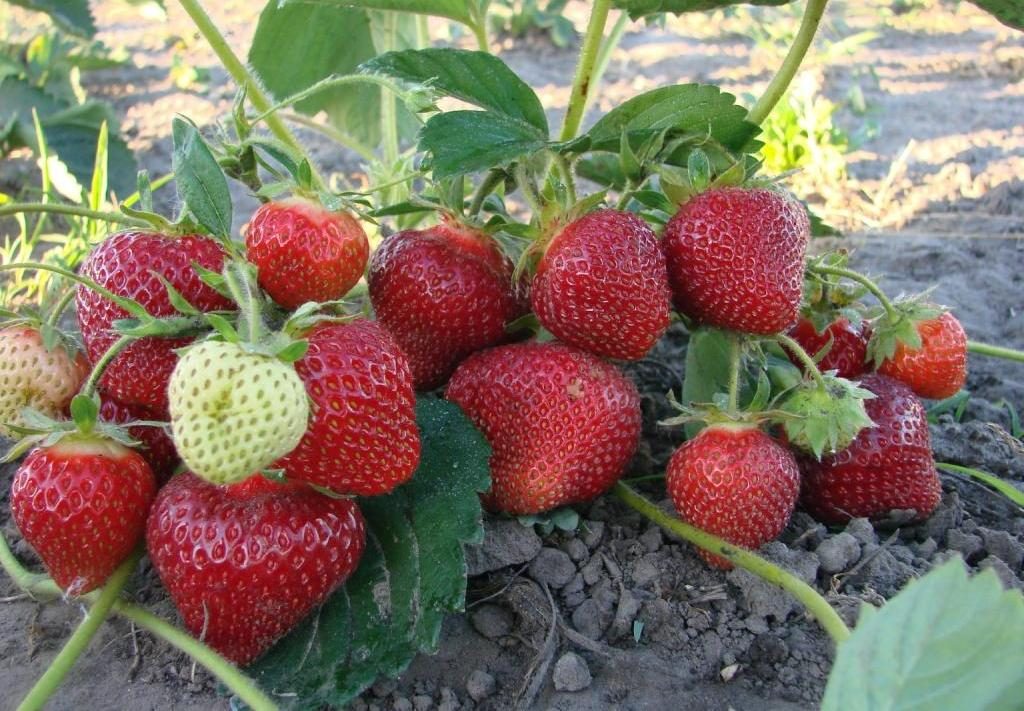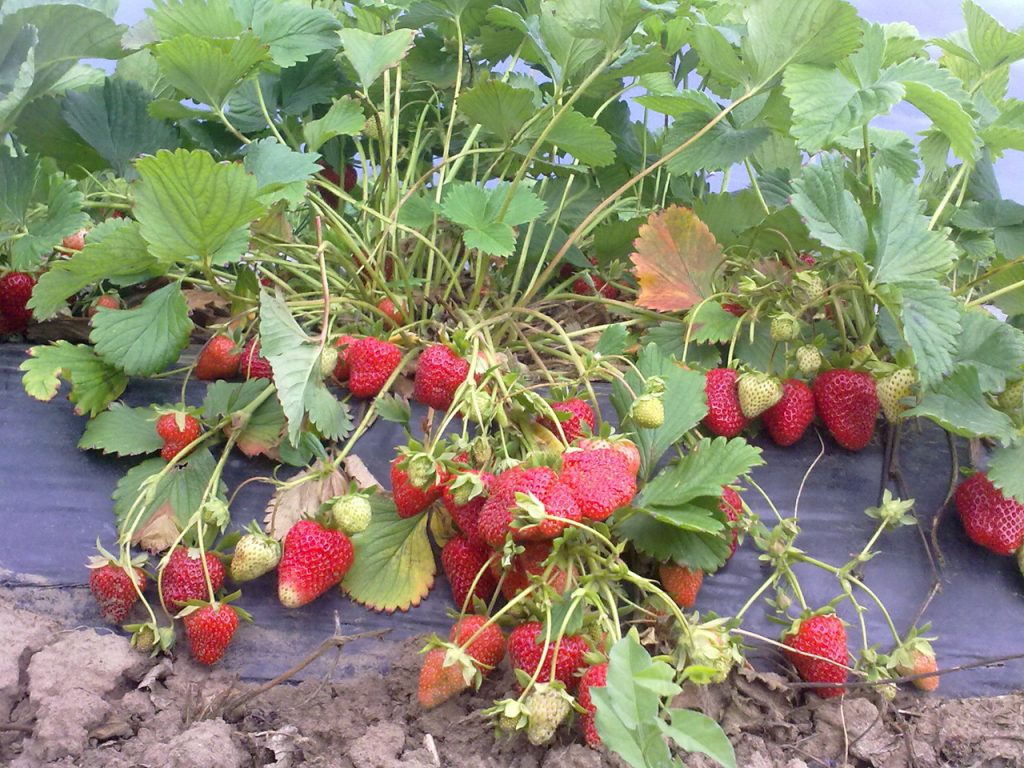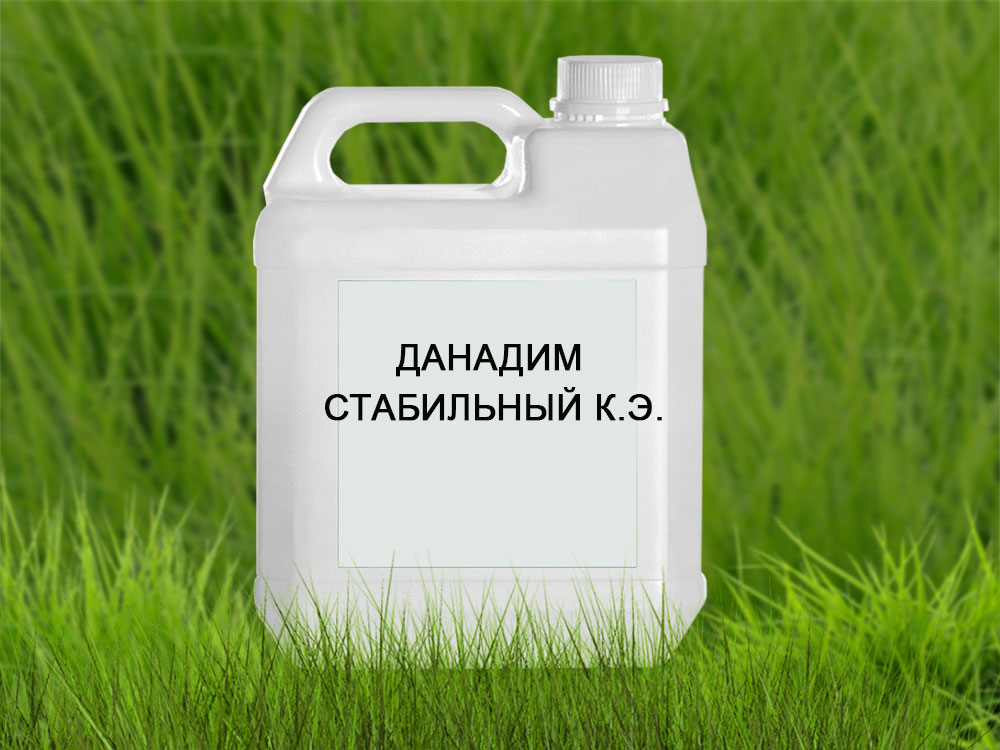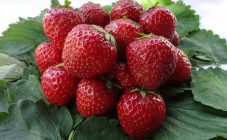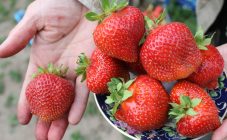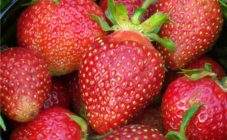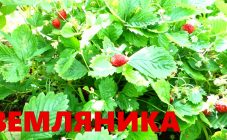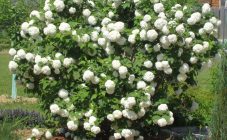Content:
Albion strawberries have been known to many Russian gardeners for over ten years. It is characterized by early ripening, high yield, excellent taste. In 2006, this remontant variety was obtained in the United States by crossing the species Diamante and Cal 94.16-1 by Californian breeders. It is not listed in the state register of Russia.
Description
The bushes are powerful, flat-spherical (height 40 - 45 cm). Leaves are dark green, shiny, slightly drooping, medium in size. The leaf plates are three-lobed, concave, and have wide, rounded teeth at the edges. The stems are strong. The flowers are medium, white, bisexual. Peduncles are long, located on top of the leaves (not in contact with the ground). Mustaches are formed in small numbers. Strawberry flowering continues until frost.
The berries are large, firm, conical, neckless, dark red, glossy. The weight of one strawberry is 40 - 60 g. Their shapes can be different: heart-shaped, oval. The cups are medium. Sepals are simple, bent upward. Seeds are few in number, slightly depressed. Their color ranges from yellow to dark red.
Characteristic
- The pulp is dense, bright pink, juicy, aromatic, sweet and sour in taste, may have voids.
- The tasting score on a five-point scale is quite high - 4.5 points.
- Large-fruited remontant strawberry Albion is distinguished by undulating fruiting. You can harvest at least four crops per season. True, in the Russian climate, the last berries planted in open beds may not ripen.
- This variety is ideal for indoor use. Approximate dates for picking strawberries: May, July, August, September. On a personal plot, from each bush it turns out from 500 grams. up to 2 kg. per season (depending on agricultural technology, weather). The first harvest can be obtained the next year after planting.
- Remaining strawberry Albion has low frost resistance. In Russia, it is preferable to plant this strawberry in greenhouses or cover it for the winter with straw, agrofibre. The southern regions (Crimea, Kuban, Chernozemnaya, Rostov region), the middle lane, the Moscow region are suitable for growing strawberries of this variety.
- Garden strawberry Albion remontant has good immunity. It is resistant to verticellous wilting, gray rot, heart decay, anthracosis, late blight, fungal diseases. Unfortunately, strawberries can be affected by white, brown spotting. Then it is treated with biofungicides.
- The plant does not tolerate hot weather (+30 degrees). In this case, fruiting slows down, the number of ovaries will be limited. Bushes can wither, fruits - decrease in size. Excess moisture is also unfavorable. The berries become watery. The palatability decreases.
Strawberry Albion reproduces in several ways:
- seeds;
- mustache;
- dividing the bush.
The last method is the most reliable. The garden strawberry Albion produces little mustache. To build them up, you need to remove the peduncles.
Planting remontant strawberries Albion
Well-lit, spacious areas are chosen for plants. They must be protected from winds and drafts. It is better to do planting work on a cloudy day or in the evening.
Bushes of strawberry Albion remontantnaya are planted in autumn (last days of August - mid-September) in the southern regions. For the middle lane, planting work is best done in spring. The place should be prepared in advance. Peat, humus and ash are added to the ridge. They're digging everything up. The plant loves loose, humus-rich soils. It would be nice to add:
- superphosphate (100g / m2);
- potassium salt (60g / m2).
Before planting the bushes, they must be kept in a cool place for a week. A distance of at least 30 cm is left between the holes. The rows are spaced from each other in a step of 40 - 50 cm. The ground under the bushes, as well as between the rows, is sprinkled with straw. This will protect the berries from mold and rot.
If necessary, shorten the roots of the plants by 10 centimeters. Soak them in a solution of any growth stimulant. Seedlings are laid out in the holes, sprinkled with soil. Tamped tightly, watered. In sunny weather, planting must be shaded.
The first mustache, peduncles are removed. Although experienced summer residents recommend rooting the strongest sockets in the same beds next to the mother specimens. They can also be cut off and planted on other sites by making special seedlings.
How to propagate Albion remontant strawberries by seeds
They select the best fruits and grind them. Placed in a vessel filled with warm water. Achenes are separated from the pulp, soaked in a stimulating solution and sown in fertile soil.
Care
This variety requires regular, abundant watering. It is best to irrigate the plant with a drip method. You need to water once every 5 - 6 days. At the same time, you should not excessively moisten the soil. To retain moisture in the ground, the bed must be mulched (straw, hay, sawdust or black agrofibre will do). Also, this procedure on hot days will protect strawberry bushes from overheating.
Strawberries are fed in early spring after the snow has melted with mineral and organic fertilizers. It is very good to add wood ash. It will increase the yield of the crop. Most popular top dressing:
- nitrophoska - it increases the amount of phosphorus in the soil;
- diammofoska - it saturates the soil with nitrogen, sulfur, and other substances;
- nitroammofoska- it allows the plant to get the maximum amount of sulfur;
- ammophos - it feeds the soil with phosphorus, nitrogen.
All of these compounds increase the resistance of plants to various diseases. During the flowering period, the bushes are fed with iron chelate. This will strengthen the roots and protect the plant from chlorosis. You can also use humus, liquid vermicompost. Various fertilizers should be applied after each flowering culture, as well as during fruit setting.
In the fall, strawberries are prepared for winter. In September, the soil is loosened at least two to three times to a depth of 5 centimeters. In October, after removing the last berries, the beds are mulched. Strawberries are sprinkled with hay, dry foliage, wrapped in white agrofibre, sawdust. Can be covered with spruce branches. In a snowless winter, a layer of rotted manure or straw is poured over it.
When caring for strawberries, you can use the following scheme:
| Spring planting works | |
|---|---|
| April | Prepare the soil: compost, humus (5 - 6 kg / m2), complex mineral compositions (40 - 60 g / m2) |
| May | Planted, watered (1 - 2 times / week). Peduncles are removed. Shelter from frost |
| June | They are fed with urea (30gr / 10l. Of water) - every 14 days |
| Autumn planting works | |
| August | Prepare the soil like spring |
| September | Bushes are planted, watered, protected from frost |
| End of September | They are fed once with phosphate-potassium fertilizers (PK 15-40) |
Diseases, pests of garden strawberries Albion
For the prevention of diseases (fungal infections), it is necessary to process the plants after the snow melts and during the flowering period. Use the fungicide Fitosporin or Glyocladin. You can prepare such a solution: 30 drops of iodine, 35 - 40 gr. laundry soap / 10 liters of water.
The preparation Topaz, copper sulphate (25 g / 10 l. Water), a solution of colloidal sulfur (55 - 60 g. / 10 l. Water) will help get rid of strawberry mites, chlorosis, light spotting.
From slugs, bushes are pollinated with ash or metaldehyde (3 - 4 g / m2). The procedure is carried out before the plants bloom, as well as after harvesting.
If a nematode attacked strawberries, use a strong insecticide (Dinadim, BI-58). And it is best to dig up infected plants and burn them.
Advantages and disadvantages of the variety
Benefits:
- remontant strawberry variety Albion has a long fruiting period;
- stored for a long time, tolerates long-distance transportation;
- berries are sweet, fragrant, have an excellent presentation, which is good for commerce;
- it is resistant to many diseases;
- fruits can be consumed both fresh and preserved.
Disadvantages:
- the harvest period is too extended;
- plants cannot tolerate dry, depleted soils, excessive moisture;
- fruits ripen for a long time (1 - 2 days);
- red, but not yet ripe berries can sour;
- can be affected by chlorosis, white, gray gily, be attacked by ticks.
Large-fruited strawberry remontant Albion has many positive qualities, it is unpretentious in care. It can be grown both on private plots and in commercial industrial production.
